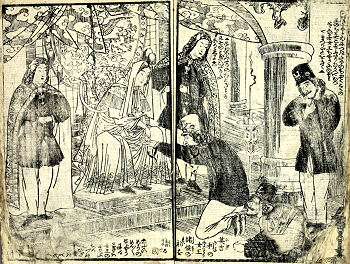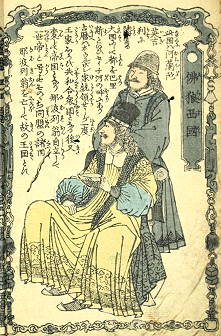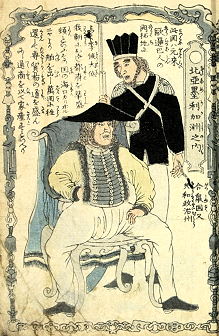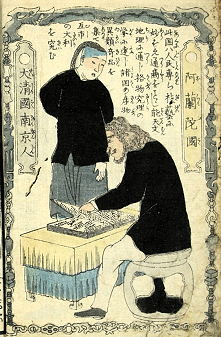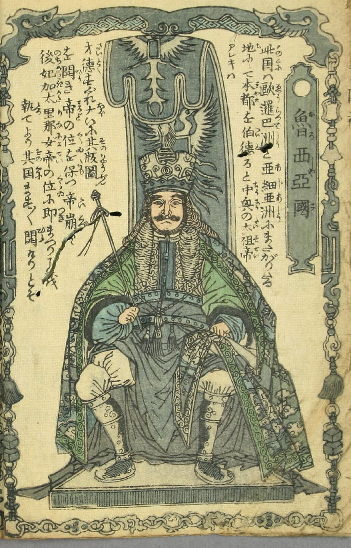Coo-Coo the après girl
ONO Saseo 小野佐世男's 1953 essay "[These] Jazz-Crazed Times" (Jazu-kyo jidai ジャズ狂時代 is a rather pedestrian look at the early-50s Jazz scene in Japan. Its thesis is "Gosh, everybody sure does love jazz these days — why, I'm starting to like it myself!" and the most interesting thing it has to say about the artists themselves is that one of them, the mysterious "Bimbo Dinau" (ビンボ・ディナウ) [update: actually Bimbo Danao], was "Manila's Bing Crosby" and spoke in broken Japanese to his audience here: "Watashi, Niponjin mina-sama suki, 'binbō' ne, 'no money' ne...". (Binbō is Japanese for "poor".)
But I did find two philological points of interest early in the piece. Let me set the scene for you. Ono is at a Sumidagawa boat rate when someone says "Oh, Mr Ono, what luck to run into you here!" He turns to see his next door neighbor...
[...] out with her daughter Coo-Coo, and looking at her wits' end.
"I just don't know what I'm going to do with Coo-Coo here, I'm so busy I'm asking the cat for help, and she demands that I take her to some silly international jazz festival. Well, I can't let an après girl like this go on her own, or who knows what she'd get up to? —so we were just on our way there, but here you are and obviously you have time on your hands. Come, come, you're always just wandering about anyway. Why don't you take this jazz-girl here to the festival instead of me? Honestly, she's such a scatterbrain I don't know what's to become of her. Very well, I leave it all in your hands, and don't forget, for all her faults she's my only daughter, my precious little jewel if you like, so don't be too unkind to her. Thank you so much! Ah, my, what a relief."
[...] 一人娘のポッポちゃんをつれて、途方に暮れた顔。
「このポッポたらしょうがないのですよ、私が猫の手でも借りたいぐらい忙しいというのに、馬鹿々々しいたら、国際のジャズ大会につれて行けっていうんですよ。こんなアプレ娘一人でやれば、何を仕でかすかわからないし、しかたがないのでここまでは来ましたが、どうせ先生は遊んでいるんでしょう。イイエ、いつもブラブラしていらっしゃいますんでしょう。このジャズ娘連れて行ってやって下さいな。ほんとにこまったオッチョコチョイ娘ですよ。ではおたのみしましたわよ、これでも私の一人娘、掌中の珠みたいなものですから、そそっかしくあつかわないでちょうだい、ではよろしくオホホ、これで安心」
So, first, the girl's nickname, which I have rendered "Coo-Coo." The original Japanese is ポッポちゃん, Poppo-chan. -Chan is of course the affectionate-dimunitive version of -san, and poppo is the noise that pigeons and doves make. A couple of paragraphs later, Poppo-chan explains that "they call me Coo-Coo because my eyes are cute as a dove's, so I'm going to use 'Coo-Coo Dove' [Hato Poppo] as my stage name [when I'm a famous jazz singer]."
It might be worth noting that a radio drama called Poppo-chan, about a young girl whose real name was "Hatoko" (remember, hato = "dove"), ran from 1954-1958, i.e. starting a year or two after this essay was published. I suppose calling girls "Coo-Coo" was in the air.
Second, dig the word apure musume アプレ娘, "après girl." The après is, as you might have guessed, from après-guerre. This is what they called frivolous teenagers in postwar Japan before the word "teenager" was imported. I have heard that apure was originally applied to the immediate postwar literary movement, but can't ever recall seeing this usage myself.
Special bonus: YouTube videos featuring artists mentioned in the essay:
- "Tokyo Rag", performed by Japanese-American Tib KAMAYATSU ティーブ・釜萢 (unusual name; I thought the katakana was a typo for "Steve" when I first saw them)
- YUKIMURA Izumi 雪村いづみ advertizing Izumi Masamune-brand sake mambo-style
- Yukimura again, singing "Alice in Wonderland"
- "Buku-buku mambo" by Tony TANI トニー・谷 (feat. a shark)
No Bimbo Dinau, though. He seems to have vanished entirely. That or Ono got his name wrong.
- Found! "You are always in my heart", by Bimbo Danao. Thanks Crusoe!
![[No-sword]](http://no-sword.jp/images/site/no-sword_banner.jpg)
